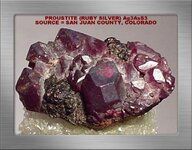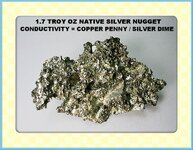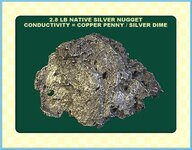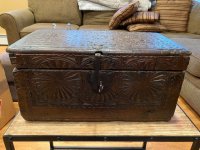You are using an out of date browser. It may not display this or other websites correctly.
You should upgrade or use an alternative browser.
You should upgrade or use an alternative browser.
Garrett ATX - Demo of the Discrimination Features
- Thread starter Bearkat
- Start date
Jim Hemmingway
Hero Member
- Jan 26, 2008
- 788
- 1,615
- Detector(s) used
- F-75, Infinium LS, MXT, GoldBug2, TDI Pro, 1280X Aquanaut, Garrett ProPointer
- Primary Interest:
- Prospecting
Thanks for doing the video Al… this is what I wanted to see. Everything seems to work fine, although the first nail test was unusual. Normally you run the coil lengthwise along a nail and it produces a low-high signal in zero discrimination and again in maximum discrimination. DD’s do sometimes call elongated iron as good high-low signals so perhaps it is that simple in this instance. But it is highly unusual for a high-low signal to switch to a low-high signal in max discrimination… can’t explain that one.
If ATX discrimination works the same as Infinium, the discrimination control is simply an adjustable pulse delay. But aside from reducing sensitivity to all metals, increasing the pulse delay should also produce a corresponding automated ground balance shift. At maximum pulse delay, the ground balance ought to shift from a zero discrimination zinc penny position to a silver dime position. Hence targets with GB positions at or below the silver dime GB point should normally produce a low conductive high-low signal in max discrimination.
We see that the penny produced a zero discrimination low-high signal followed by a maximum discrimination high-low signal… this would appear to confirm the GB shift occurred. So how to explain a zero discrimination high-low nail signal switching to a maximum discrimination low-high signal. It was swept in the same direction, so it’s physical / conductive characteristics were unchanged with respect to it’s profile to the coil… hmm.
You mentioned in the video that you don’t use this feature much, so thanks again Al for doing this video as a favor to us interested viewers.
Jim.
If ATX discrimination works the same as Infinium, the discrimination control is simply an adjustable pulse delay. But aside from reducing sensitivity to all metals, increasing the pulse delay should also produce a corresponding automated ground balance shift. At maximum pulse delay, the ground balance ought to shift from a zero discrimination zinc penny position to a silver dime position. Hence targets with GB positions at or below the silver dime GB point should normally produce a low conductive high-low signal in max discrimination.
We see that the penny produced a zero discrimination low-high signal followed by a maximum discrimination high-low signal… this would appear to confirm the GB shift occurred. So how to explain a zero discrimination high-low nail signal switching to a maximum discrimination low-high signal. It was swept in the same direction, so it’s physical / conductive characteristics were unchanged with respect to it’s profile to the coil… hmm.
You mentioned in the video that you don’t use this feature much, so thanks again Al for doing this video as a favor to us interested viewers.
Jim.
Bearkat
Full Member
- Aug 12, 2007
- 180
- 83
- Detector(s) used
- GTI 2500/Infinium LS/ Ace 250/ Scorpion Gold Stinger/AT Gold/AT Pro
- Thread starter
- #3
Hi Jim,
After Garrett viewing this video they informed me that the "Discrimination/Pulse-Delay functions of the ATX and the Infinium are effectively the same and The ATX's Iron Check button, on the other hand, does not use this delay method at all. Rather, it uses a completely different/independent circuit to determine if the target is ferrous or not."
knowing this, I will use this more as well as incorporating it with the ATX's iron check button for a double wammy on target id.
Thats pretty cool eh Jim...
Alan
After Garrett viewing this video they informed me that the "Discrimination/Pulse-Delay functions of the ATX and the Infinium are effectively the same and The ATX's Iron Check button, on the other hand, does not use this delay method at all. Rather, it uses a completely different/independent circuit to determine if the target is ferrous or not."
knowing this, I will use this more as well as incorporating it with the ATX's iron check button for a double wammy on target id.
Thats pretty cool eh Jim...
Alan
Jim Hemmingway
Hero Member
- Jan 26, 2008
- 788
- 1,615
- Detector(s) used
- F-75, Infinium LS, MXT, GoldBug2, TDI Pro, 1280X Aquanaut, Garrett ProPointer
- Primary Interest:
- Prospecting
Hi Jim,
After Garrett viewing this video they informed me that the "Discrimination/Pulse-Delay functions of the ATX and the Infinium are effectively the same and The ATX's Iron Check button, on the other hand, does not use this delay method at all. Rather, it uses a completely different/independent circuit to determine if the target is ferrous or not."
knowing this, I will use this more as well as incorporating it with the ATX's iron check button for a double wammy on target id.
Thats pretty cool eh Jim...
Alan
Way cool… definitely a double whammy that adds to the ATX’s capability. But I think that some readers / viewers will be confused about when and how to use the discrimination feature while prospecting Al, so below is a summary about how I use it here in the silverfields. The bottom line is that for general searching in most areas it should not be used except to check questionable target signals. BTW... I stick to Infinium’s mono coils, they tend to handle iron better than the DDs.
Regardless of ground mineral conditions encountered in Ontario’s silver country to date, I’ve found that any silver ores, quantities of iron trash, and other non-ferrous targets at or below the zinc penny GB position will produce a low conductive high-low signal both in zero discrimination and in maximum discrimination. Many zero discrimination low conductive signals will lose some or all their signal strength in maximum discrimination. Such signal strength loss in max discrimination mostly depends on the physical / conductive traits of the target, and with target depth. All such signals must be dug, and unfortunately these do include small or flat low conductive iron that typically resides in the VLF iron range.
Targets above the zinc penny GB position will produce a high conductive low-high signal in zero discrimination. These include much rarer high conductive silver, and plenty of larger iron that is always present in mining areas. For example… larger drill bits and milling balls, drill rods, implements, rail spikes, and most nails. A good portion of this iron resides in the non-ferrous range of a VLF target ID, or bounces between iron and non-ferrous readouts. In excessively trashy areas you can ignore zero discrimination low-high signals and eliminate digging considerable iron. But you will also eliminate any chance of finding occasional high conductive silver.
On the other hand, lets say we acquire a low-hi zero discrimination signal, but want to check it in maximum discrimination to see if it could be high conductive silver. If it switches to a high-low signal in max discrimination, we know the target resides in a GB range from zinc penny to silver dime inclusive. It could be silver but the odds always favor that it is iron… its your decision whether to dig. Generally in this range, although depth is a big variable, iron retains more signal strength than do silver ores, so if the signal volume decreases significantly or disappears altogether… dig the target without fail.
If the signal remains a low-high signal in max discrimination… indicating a GB point beyond the silver dime GB position… you can ignore it because it will prove to be iron in my area. Naturally occurring native silver here… our silver ranges from foil to silver dime conductivity… will not produce a low-high tone in reverse discrimination in my experience. Although such silver possibly exists, it is so extremely rare as to not warrant consideration as a practical detecting matter.
But conditions can and do vary in other locations. We need look no further than Michigan’s Upper Peninsula, a source of high purity copper specimens that commonly produce high conductive VLF target ID readouts in the quarter to half-dollar range. These specimens do produce a low-high signal both in zero and reverse discrimination. Perhaps the same could apply to silver and gold elsewhere… one shouldn’t totally discount that possibility, nor forget that no discrimination system is infallible.
I’ve described in the above post my view of how the ATX / Infinium discrimination control works (adjustable pulse delay that correspondingly shifts the relative GB position). In a strictly prospecting context, other than searching conductive wet salt environs or sites dominated by coke–slag-cinder-ash mixtures that are occasionally encountered in mining camps, the discrimination control should be left at the most sensitive minimum position for general searching in prospecting applications. Learn to identify occasional hotrocks that beep and ignore them if you can, otherwise one can use the ground balance feature to deal with hotrock patches if necessary. Some hotrock types may also respond to the ATX’s “iron check” feature as demonstrated in an earlier video.
Final comment Al to do with the video. The iron check should work for shallow nails and so forth to maybe four or five inches… and most nails and small iron tend to be shallow. While I doubt it will identify deeper larger iron, for example a drill rod down a foot or more… the discrimination feature ought to identify such iron as low-high signals in both zero and maximum discrimination. At the very least, I’d be happy if the iron check can identify some of the small iron that produces diggable low conductive high-low signals.
It would have been good to run the iron check over the first nail that produced a high-low signal in the video. And ditto for that rusty sheet metal piece that also produced a high-low signal. Do you suspect or think the iron check feature is a VLF circuit? Thanks Al… it’s a real pleasure to speak with you… but no more lengthy posts from me… scout’s honor!!!
Jim.
Last edited:
Bearkat
Full Member
- Aug 12, 2007
- 180
- 83
- Detector(s) used
- GTI 2500/Infinium LS/ Ace 250/ Scorpion Gold Stinger/AT Gold/AT Pro
- Thread starter
- #5
Hey Jim thats a good read man! Pretty much my conclusion on using the Infinium's disc. Once you get all that down it can be done quite quickly in the field.
Yea; I did not think of doing the iron check on the first iron targets till I got to the second batch. Garrett has told me that the iron check is definately and separate circuit, but what kind I'm not sure. Like you said, do iron check first, and if no grunt, try the "reverse disc" on the ATX to give you more info to dig. I have almost got to the point where if it grunts in iron check, I won't dig it, as all my grunt targets have been iron of some sort.
Jim, check out the ATX Findmall forum I just put a short post up about using the ground balance features of the ATX on there...just a short post but needed info.
P.S. I have a medium size silver nugget and a large copper nugget I can do some test on with the ATX if you would like to see them??
Thanks,
Alan
Yea; I did not think of doing the iron check on the first iron targets till I got to the second batch. Garrett has told me that the iron check is definately and separate circuit, but what kind I'm not sure. Like you said, do iron check first, and if no grunt, try the "reverse disc" on the ATX to give you more info to dig. I have almost got to the point where if it grunts in iron check, I won't dig it, as all my grunt targets have been iron of some sort.
Jim, check out the ATX Findmall forum I just put a short post up about using the ground balance features of the ATX on there...just a short post but needed info.
P.S. I have a medium size silver nugget and a large copper nugget I can do some test on with the ATX if you would like to see them??
Thanks,
Alan
Last edited:
Jim Hemmingway
Hero Member
- Jan 26, 2008
- 788
- 1,615
- Detector(s) used
- F-75, Infinium LS, MXT, GoldBug2, TDI Pro, 1280X Aquanaut, Garrett ProPointer
- Primary Interest:
- Prospecting
Doggone it Alan… when ol’ Santa checks your list twice, there ought to be a snootful of presents under the tree for you this Christmas, because you’ve definitely been nice!!!! 
OK… if you’re planning to do another video, by all means test the copper and silver nuggets. If you still have that “high-low” nail and rusty piece of sheet metal, maybe they could be included too. If you don’t have them handy, could you try another thin flat rusty piece of sheet metal about an inch or three in diameter, and any other piece of non-descript small iron that gives a high-low ATX signal in zero discrimination.
It might be an idea to run the AT Gold with the iron audio enabled (at a practical iron setting) over the nuggets to confirm their target ID, and then over the iron samples as a means of comparison with the ATX iron check. It will be instructive to see how each unit responds.
I suggest running the ATX in zero discrimination over each sample, followed by maximum discrimination to see what signal each target produces.
There is probably no point in checking these samples at mid-level discrimination settings. It’s a bit of an information overload. And while perhaps useful for non-prospecting applications, mid-discrimination settings have no real utility to prospectors for either general searching or meaningful target signal evaluation over iron, nuggets or ores.
The above are just ideas Al… I don’t want to come off sounding like your film director… anything you do is fine by me. I’m happy with what you’ve done to date, so anything more is a bonus.
The two photos below both depict silver nuggets at quite different sizes but the same VLF target ID. Both occupy similar GB positions with respect to PI unit ground balance scales. Any silver nugget or ore at or below a silver dime GB position will produce a high-low signal in maximum discrimination. Both produce zero discrimination low-high signals because their GB positions exceed the zinc penny GB point, but to reiterate... these switch to high-low signals in max discrimination.
Jim.
OK… if you’re planning to do another video, by all means test the copper and silver nuggets. If you still have that “high-low” nail and rusty piece of sheet metal, maybe they could be included too. If you don’t have them handy, could you try another thin flat rusty piece of sheet metal about an inch or three in diameter, and any other piece of non-descript small iron that gives a high-low ATX signal in zero discrimination.
It might be an idea to run the AT Gold with the iron audio enabled (at a practical iron setting) over the nuggets to confirm their target ID, and then over the iron samples as a means of comparison with the ATX iron check. It will be instructive to see how each unit responds.
I suggest running the ATX in zero discrimination over each sample, followed by maximum discrimination to see what signal each target produces.
There is probably no point in checking these samples at mid-level discrimination settings. It’s a bit of an information overload. And while perhaps useful for non-prospecting applications, mid-discrimination settings have no real utility to prospectors for either general searching or meaningful target signal evaluation over iron, nuggets or ores.
The above are just ideas Al… I don’t want to come off sounding like your film director… anything you do is fine by me. I’m happy with what you’ve done to date, so anything more is a bonus.
The two photos below both depict silver nuggets at quite different sizes but the same VLF target ID. Both occupy similar GB positions with respect to PI unit ground balance scales. Any silver nugget or ore at or below a silver dime GB position will produce a high-low signal in maximum discrimination. Both produce zero discrimination low-high signals because their GB positions exceed the zinc penny GB point, but to reiterate... these switch to high-low signals in max discrimination.
Jim.
Last edited:
Top Member Reactions
-
 2582
2582 -
 1151
1151 -
 1066
1066 -
 898
898 -
 868
868 -
 850
850 -
 789
789 -
 691
691 -
 638
638 -
 569
569 -
 488
488 -
 478
478 -
 475
475 -
 464
464 -
 457
457 -
 430
430 -
O
420
-
 391
391 -
 380
380 -
 359
359
Users who are viewing this thread
Total: 2 (members: 0, guests: 2)






